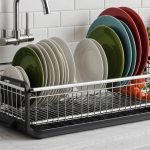If you’re struggling with keeping your pantry organized due to space constraints, don’t worry, you’re not alone. Managing a pantry, especially in a small kitchen, can seem like a daunting task. But with the right ideas and strategies, you can transform this space into a well-organized storage area. In this post, we will highlight some efficient ways to make the most out of your available pantry space. Let’s dive in.
Understanding Your Pantry Space
Before you dive into rearranging your pantry, it’s essential to understand the space you have. Get a sense of the overall layout. Take note of the shelves, bins, door and other storage spots. This awareness will help you make informed decisions on how best to use these areas for maximum storage efficiency.
Also read : The Ultimate Guide to Choosing the Perfect Waffle Iron Size for Belgian and American Waffles
Shelves and bins are particularly useful for pantry organization. Group similar items together in bins, keeping them accessible and easy to find. Use shelves for larger items or those you use frequently.
What to Store in Your Pantry
Knowing what to store in a pantry is fundamental. It’s easy to stuff everything and anything into this space, but that won’t help with organization.
Also to see : The definitive handbook for choosing the ideal non-stick bread proofing basket for flawless loaves every time
Primarily, a pantry should store food items. Think about canned goods, dry pasta, rice, cereals, snacks, baking ingredients, and spices. Non-food items such as kitchen appliances, dishware, and plastic bags can also find a home in your pantry if you have extra space.
But remember, the key is to keep things organized. Don’t just throw items in. Designate certain shelves or bins for particular goods. For instance, you could have a shelf for canned goods and another for baking items.
Using Containers for Better Organization
Containers are your best friend when it comes to pantry organization. They come in all shapes, sizes, and materials, so you can choose what works best for you.
Invest in clear containers for items like cereals, flour, pasta, rice, and other dry goods. Not only will they keep your food fresh, but they also allow you to see what’s inside without having to open each one. Label each container, and you’ll never have to waste time searching for that elusive bag of brown sugar again.
Smaller containers or baskets can be used for snack bars, spice packets, or other small items that can easily get lost among larger goods.
Maximizing Door Space
The pantry door is often an overlooked space for storage. But when organized well, it can provide an additional area to store items.
You can install a door rack that features multiple shelves or pockets. Use this space for storing smaller items or those you use frequently, like spices, oils, or snack bars.
Alternatively, use adhesive hooks to hang items like aprons, dish towels, or reusable shopping bags. This method keeps these items accessible and frees up space elsewhere.
Rotating Items Regularly
A crucial part of keeping a pantry organized is regular rotation of items. Just like in a grocery store, move older items to the front and place newer purchases in the back. This method ensures you use up items before they expire, reducing waste.
It’s also a good idea to take a regular inventory of what’s in your pantry. Remove items that are expired or that you know you won’t use. This practice frees up space for items you will use, and keeps your pantry from becoming cluttered with unnecessary items.
Remember, efficiently organizing a pantry with limited space is all about making smart use of the space you have. With thoughtful placement, regular rotation, and the right containers, you can transform your pantry into a well-organized and functional space. And while it may require some time and effort initially, the benefits of an organized pantry will certainly make it worthwhile.
Exploring Vertical Space for Additional Storage
For a small pantry, vertical space can be a game-changer. Often, there is unused space above the top shelf or below the bottom one. Utilizing these areas can significantly increase your storage capacity.
Consider installing an additional shelf on top if there is ample space. This shelf can store items that are not frequently used but still necessary, such as extra canned goods, dry goods, or even small kitchen appliances. Similarly, if there is space underneath the lowest shelf, consider adding baskets or bins for additional storage.
The pantry door also offers vertical storage possibilities. As mentioned earlier, door racks or hanging baskets can be used to store smaller items.
Another innovative pantry organization idea is to use a tension rod. Installing a tension rod across your pantry can create an additional hanging space. Utensils with loops, small baskets, or even dish towels can be hung here.
Finally, let’s not forget that walls can also be used for vertical storage. Wall-mounted spice racks, magnetic strips for knives, or even pegboards for hooks and baskets can transform your pantry walls into a powerful storage resource.
Maximizing Your Kitchen Cabinets for Pantry Storage
When pantry space is limited, kitchen cabinets can become a lifeline. With the right organization, kitchen cabinets can serve as an extension of your pantry.
Begin by emptying your cabinets and sorting the items into categories. This process allows you to visualize your space and understand how best to organize it.
Next, decide what items you will store in your cabinets. Items that are used less frequently are perfect for this space. Consider using your cabinets for storing larger items like kitchen appliances, baking trays, large pots, or bulky items like a bag of flour or rice.
Use storage containers and bins to keep things tidy. Smaller items can be stored in containers or bins to prevent them from getting lost or cluttered. You can also use shelf risers to maximize the vertical space within your cabinets.
Remember to keep items visible and accessible. Avoid stacking items behind each other, as it makes it hard to see and reach items at the back.
To further maximize your cabinet space, consider adding hooks on the inside of cabinet doors. These hooks can hold measuring cups, potholders, or even small pots and pans.
Conclusion
Achieving an efficient pantry organization in a small kitchen with limited pantry space may seem like a daunting task. But with the right strategies in place, it is indeed possible. Understanding your pantry space, using storage containers, maximizing door and vertical space, rotating items regularly, and utilizing kitchen cabinets can significantly enhance your pantry’s efficiency.
The key is to keep your pantry and cabinets clutter-free and everything in its designated place. While it might require some time and effort initially, the benefits of an organized pantry will certainly make the process worthwhile. You will save time searching for items, reduce food waste, and make meal preparation more enjoyable. Plus, an organized kitchen is pleasing to the eye and creates a more relaxing environment.
So, start today and transform your small pantry into a well-organized, functional, and efficient food storage space.








